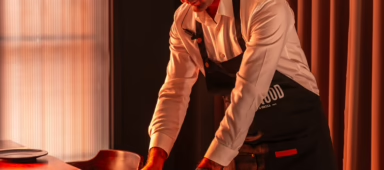Share the love in the city of smiles, selfies, and social media

GETTING AROUND
TAGLISH
Communicating is easy in the Philippines. Tagalog may be the national language but nearly everyone speaks or at least understands some English. Filipinos are fond of speaking both languages simultaneously, hence the hybridization called Taglish. For instance, you can thank someone respectfully in Tagalog by saying salamat po, though saying thank you po is just as common.
GRAB IT
Ride sharing services like Grab or Uber are the safest and most convenient way of getting around. Cars are cleaner and more comfortable than taxis. On top of that, drivers use Waze to find the quickest ways through Manila’s hellacious traffic.
SUMMERY BUT MODEST
Manila is hot and humid, so light clothing is a must. However, it’s also conservative, so it’s best to keep overly revealing clothing for the beach. Flip-flops are fine during the day, but for more formal establishments like upscale bars and restaurants, it’s best to go smart casual.
PUBLIC JEEPNEYS
Jeepneys are an iconic symbol of Manila. They aren’t the easiest way of getting around but they’re fun and cheap, with fares starting at just PHP 8. Spend an afternoon riding around in a public jeepney to experience the real Manila.

WHAT TO DO
THE WALLED CITY
Intramuros is the oldest district and historical centre of Manila. If you have time to visit just one place, this should be it. Make your visit more memorable by going on a bamboo bike tour with Bambike Ecotours. Not only is it a fun way of seeing Intramuros, it’s also for a good cause.
WALK THIS WAY
If touring Intramuros on bikes isn’t your thing, perhaps you could go on a walking tour with celebrity guide Carlos Celdran. A tour of Intramuros with Carlos is like watching a one-man theatrical performance. You’ll meet up at San Agustin Church, one of four Philippine churches designated as a UNESCO World Heritage Site. Just look for the man in the top hat.
RIZAL MONUMENT
Dr. Jose P. Rizal is a Philippine National Hero. Visitors can pay their respects at Rizal Monument, which is one of Manila’s most recognisable landmarks. His remains are interred there.
NATIONAL MUSEUM
Spend a day at the National Museum of the Philippines, which houses important historical artefacts as well as the country’s finest collection of Philippine art. There you can admire Spoliarium by National Artist Juan Luna, considered by many as one of the Philippines’ greatest works of art. Admission is free.
BINONDO FOOD ‘WOK’
What better way to explore the world’s oldest Chinatown than through its food? Go on a culinary walking tour of the Binondo district with Ivan Man Dy of Old Manila Walks. Bourdain fans may recognise him as one of Anthony’s guides on the Philippine episode of No Reservations.
IT’S A MALL WORLD
Manila is all about shopping malls. In fact, we have some of the world’s biggest. Head on over to Mall of Asia to catch Manila bay’s famous sunset. If quality fakes and bargains are your thing, then Greenhills Shopping Centre is the place to go.
BONIFACIO GLOBAL CITY (BGC)
BGC is one of the trendiest areas. Many of the city’s best restaurants can be found there. Take a stroll through Bonifacio High Street, a kilometre-long twin shopping boulevard with interactive art displays along a central park.
CINEMA PARADISO
Film buffs will be pleased to find film festivals being held in Manila almost every month. If you like indie films, go for the Cinemalaya Film Festival in July or August. If you’re in town over the holidays, you may want to catch the Metro Manila Film Festival, which opens on Christmas Day every year.
WHERE TO EAT
GET INTO A BOODLE FIGHT
A tradition of the Philippine Military Academy, boodle fights are a fun way for visitors to experience Filipino cuisine. A mountain of rice and Filipino staples like Adobo, pork belly, and crab are spread out over banana leaves and eaten with your bare hands. Go to Blackbeard’s Seafood Island for some of the tastiest boodle fights in the city.
FOOD STREETS
Filipinos love to eat. Some of Manila’s most popular food neighbourhoods are Maginhawa Street in Quezon City, Aguirre Street in Parañaque, and Barangay Kapitolyo in Pasig. There you’ll find homegrown restaurants frequented by the city’s most passionate foodies.
POBLACION
Hang out with hipsters and expats at this up-and-coming neighbourhood in Makati filled with unpretentious bars and restaurants. Tambai with its yakitori sticks is a favourite, as is Mexican restaurant El Chupacabra.
WHERE TO HANG OUT
ROCK. DINE. ROLL.
Most Filipinos love to sing, even the ones that shouldn’t. Belt out Bruno Mars ballads at Red Box Karaoke in Greenbelt 3. A little shy? Don’t worry. You’ll be rocking out in your own private karaoke room.
BOHEMIAN RHAPSODY
Filipinos love listening to live music too. Rock out to live bands belting out iconic cover tunes and Original Pinoy Music (OPM) at 12 Monkeys Music Hall and Pub.
SPEAK EASY
Secret bars have been making a lot of noise in Manila lately. For a glam night out, walk through a 7-Eleven storage closet to mingle with Manila’s finest at Bank Bar in Bonifacio Global City.
DAY TRIPS
TAAL VOLCANO
Around two hours south of Manila is Tagaytay City, a popular day trip destination that boasts one of the most picturesque views in the Philippines. From the ridge, you can admire Taal Volcano sitting in the middle of Taal Lake. It holds the distinction of being the world’s smallest active volcano.
WALK BACK IN TIME
If you’re making a day trip to Taal Volcano, pair it with Taal Heritage Town. Similar to Vigan in Ilocos Sur, it’s home to a wealth of well-preserved Spanish colonial houses as well as Southeast Asia’s largest basilica.
REMNANTS OF WAR
War history buffs will want to spend the day on Corregidor, an island used to defend Manila against attacks by enemy warships during WWII. On the island are military installations and war-ravaged buildings restored for tourism. It’s a little over an hour from Manila by ferry.
INTERESTING NUGGETS
VINTAGE CHIC
If you like hotels with character, you’ll love The Henry Hotel, a 34-room boutique hotel set in an old compound of two-storey heritage houses built in the 1950s.
PACIFIC RIM
Despite the Filipino’s diminutive stature, basketball is huge. It’s so popular that it’s almost like another religion. Pick up Rafe Bartholomew’s entertaining book Pacific Rim for a deeper understanding of the Filipino’s love for basketball.
#ITSMOREFUNINTHEPHILIPPINES
Filipinos love social networking. In fact, Time magazine once called Manila the selfie capital of the planet. Snap a selfie when you’re there and share the love on social media. Filipinos will “like” you for it.
TRAVEL TIPS
TWO SEASONS
Manila has two seasons – rainy and dry. The rainy season is from June to October while the dry season is from November to May. November to February are the coolest months of the year and the best time to visit.
PESOS PLEASE
The Philippine peso (PHP) is the official currency. When you arrive, exchange a small amount at the airport, just enough to get you to your hotel, then change the rest at shopping mall money changers. They’re safe and generally offer the best rates.
DRIED MANGOES
Filipinos are proud of their mangoes, which are some of the world’s sweetest. Before leaving, pick up a few packs of dried mangoes. They’re delicious and a favourite gift item.
About the writer
JB Macatulad is a graphic designer and travel blogger based in Manila. He and his wife Renee are the Traveleaters behind Will Fly For Food, a travel blog for the gastronomically inclined.





